Project background
Sea Turtle Conservancy has been monitoring and protecting critical nesting beaches for endangered green turtles and Kemp’s ridley turtles for decades. The primary nesting site for green turtles in the Western Hemisphere is at Tortuguero, Costa Rica, where STC has worked since 1959. The main nesting site for Kemp’s ridleys is located in Rancho Nuevo, Mexico. These coordinated efforts have stopped the decline of these species and both populations are showing signs of recovery.
Project activities
This project was carried out within critical in-water foraging habitat in the Northeast Gulf of Mexico. Many of the juvenile sea turtles that grow up in this area were hatched at nesting sites around Central America and the Caribbean. Once they mature, a process that can take 20 years, these turtles will return to nesting sites throughout Mexico, Costa Rica, Panama and other developing nations in Central America and the Caribbean, where they serve as critical drivers of ecotourism that many small coastal communities rely upon as a sustainable source of income. Financial support from World Nomads’ Footprints Network provided resources to carry out a program with the following primary goals:
- Conduct visual transect surveys in the Northeast Gulf of Mexico to determine the abundance of juvenile sea turtles inhabiting the region.
- Collect biometric data about sea turtles found in this habitat in order to establish baseline health assessments of the population and to tag individual turtles that can be tracked over time.
- Identify the main threats facing sea turtles in the area and implement strategies to reduce those threats.
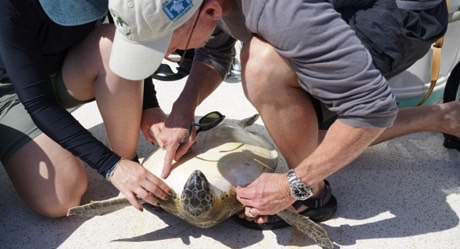
Project results
Goal 1
STC launched an in-water sea turtle conservation program in the coastal waters of the northern Gulf of Mexico, focusing on turtle foraging habitat from Florida’s Panhandle south to Crystal River. Using a research vessel equipped with a tower for spotting turtles, STC conducted visual transect surveys covering 642 km of Florida’s northwest coast. Transect surveys involved driving STC’s research vessel for an average of 7 km, perpendicular to shore. If a sea turtle was spotted during a transect survey, its species and distance from the boat were recorded.
From September 2018 to June 2019, STC documented 356 loggerhead, green, Kemp’s ridley and hawksbill sea turtles during transect surveys. The majority of sea turtles recorded were green turtles (74%). STC discovered more than a dozen previously unreported “hot spots,” or areas of higher abundance of sea turtles, in this region. As more hot spots are discovered, STC will aim to figure out why the turtles congregate in these areas, and we will be able to use that data to inform conservation strategies.
The northern Gulf of Mexico serves as developmental habitat for young turtles that grow up and return to nesting beaches around the Caribbean and Latin America – where local communities are waiting on their return for their own sustainable livelihoods. By learning about why turtles are clustering in specific areas in the northern Gulf of Mexico, STC will be better able to advocate for the protection of this critical developmental habitat for sea turtles.
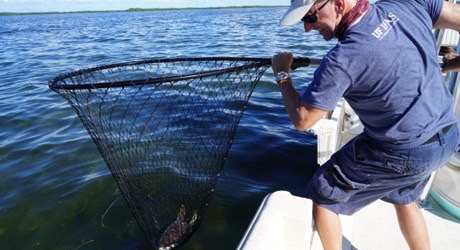
Goal 2
STC collected biological information needed to monitor the health and recovery of both sea turtle species that populate the Wider Caribbean and Gulf of Mexico. By using a dip net, STC captured mostly green turtles during the timeframe of this project. Once a turtle was on the boat and made comfortable, staff measured and weighed the turtle, inspected it for signs of injury, and took blood samples from the turtle to determine its sex and its “natal beach” (the beach from which the turtle hatched).
As STC continues capturing and studying turtles in this area, the data will help us understand what proportion of turtles come from Costa Rica, Mexico and the rest of the Caribbean. STC also tags each turtle with a metal flipper tag and a PIT tag (similar to a dog microchip). Once staff collected information from captured turtles, they were released in the same area that they were found. By recording biometric information about the juvenile turtles inhabiting this area, STC will establish a baseline that will allow us to understand population trends and potential threats to survival.
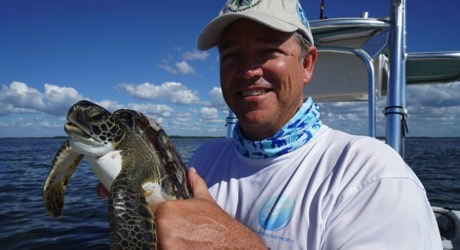
Goal 3
While the coastline of the Northeastern Gulf of Mexico has been mostly spared from major coastal development, its fragile marine ecosystems still face a number of threats. The Deepwater Horizon oil spill, one of the worst spills of its kind in the world, happened in the immediate vicinity. Scalloping and fishing seasons bring thousands of people to the area each year, leaving juvenile turtles vulnerable to boat strikes.
The area’s seagrass, which is the main food source for juvenile green turtles, is at risk from boat scarring, oil spills and impacts from climate change. During this grant period, STC tracked the amount of boat traffic and interacted with anglers on a daily basis to educate them on the importance of sea turtles to this region. When interacting with fishermen and community members, STC was respectful to local cultures and worked to avoid harmful impacts to the local community. STC needs locals to support turtle conservation and feel they are contributing in ways that don’t harm livelihoods, which is certainly achievable.
Another threat to sea turtles in this area, specifically to green turtles, are fibropapilloma tumors thought to be caused by land-based nutrient runoff. A majority of the green turtles STC caught during this grant period had fibropapilloma tumors. When turtles are found with life-threatening tumors or injury, STC rescues these turtles and transports them to one of several sea turtle rehabilitation centers operating in the region. Now that STC will have a permanent presence in this area, we will have the ability to track the severity of this threat to sea turtles and measure if it is increasing over time. As this project continues long-term, STC will work to decrease threats to sea turtles in this area through ongoing educational outreach, advocacy on behalf of the animals, and direct intervention to rescue sick and injured turtles.
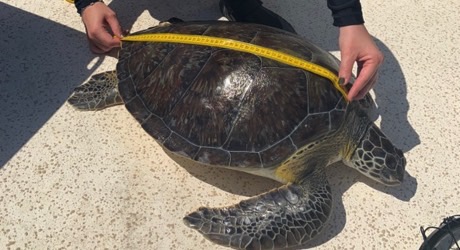
Community involvement
As STC has traveled to remote areas of the Gulf of Mexico coastline, we have encountered dozens of local residents and fishermen who have approached us to thank us for working in the area protect the sea turtles. We were surprised to find so many local people supporting the project and even volunteering information about where they are spotting turtles in the water themselves.
What next?
As more knowledge is gained on the sea turtles in this region, STC will work with wildlife managers to reduce threats using effective long-term strategies. This project is a logical evolution of the work STC has carried out for six decades, and it is needed to ensure all the work invested over the years is not lost. The sea turtles themselves and coastal communities throughout the Caribbean and Latin America are counting on STC to protect the turtles while they growing up in the north Gulf of Mexico.
These turtles are known to return to nesting sites throughout Mexico, Costa Rica, Panama and other developing nations in Central America and the Caribbean, where they serve as critical drivers of ecotourism that many small coastal communities rely upon as a sustainable source of income.
Project Background
Sea Turtle Conservancy has been monitoring and protecting critical nesting beaches for endangered green turtles and Kemp’s ridley turtles for decades. The primary nesting site for green turtles in the Western Hemisphere is at Tortuguero, Costa Rica, where STC has worked since 1959. The main nesting site for Kemp’s ridleys is located in Rancho Nuevo, Mexico. These coordinated efforts have stopped the decline of these species and both populations are showing signs of recovery.
However, protecting nesting beaches is just one step in ensuring the full recovery of sea turtles. Green turtles and Kemp’s ridleys are highly migratory and spend different phases of their lives in different locations. It is essential that conservation programs are carried out where sea turtles spend most of their lives – in the water. Juvenile green turtles spend their time foraging on productive seagrass beds (also known as “developmental habitat”). The coastal waters of the northern Gulf of Mexico provide important development habitat for young green turtles that were hatched all over the Wider Caribbean. Young Kemp’s ridleys also are found there in large numbers.
Unfortunately, there are no systematic monitoring and conservation programs in place to track the populations and address growing threats, such as ingestion and entanglement in marine debris, habit degradation, commercial fishing, boat strikes, diseases related to water quality and climate change. These threats must be understood and reduced in order to ensure that the decades of conservation work is not lost.
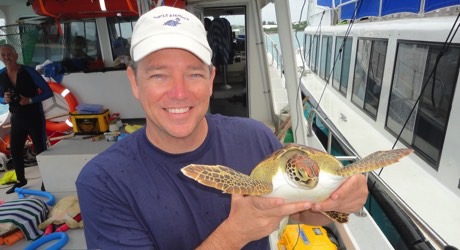
Project Overview
STC will launch an in-water sea turtle conservation program in the coastal waters of the northern Gulf of Mexico. The initial phase will focus on turtle foraging habitat from Florida’s Panhandle south to Crystal River. This stretch of the Gulf coast is globally important to the recovery of sea turtles, and this project will fill important gaps in our ability to conserve some of the world’s most important sea turtle populations.
The project involves monitoring carried out at regular intervals throughout each year. The work will take place on an STC research vessel that accommodates a team of 4-6 people. The project will include 1) visual transect surveys, during which the species and number of turtles visible along a pre-determined course are counted, and (2) a tagging program that includes the collection of important biometric data about turtles found in this habitat. As funding permits, a subset of turtles will be satellite-tracked in order to assess habitat usage and migratory movements.
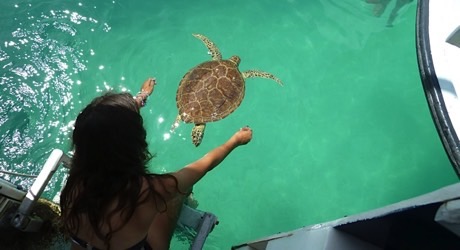
In addition to collecting important biological information about the turtles, STC will track various threats to sea turtles and implement strategies to reduce those threats. The project also will rescue turtles impacted by debris, boat strikes and disease. An outreach campaign will target commercial and recreational fishing community in the region, with the goal of reducing interactions between turtles, boats and fishing gear.
Through this program, STC will collect biological information needed to monitor the health and recovery of both green and Kemp’s ridley turtles that populate the Wider Caribbean and Gulf of Mexico. We also will reduce threats encountered by the turtles while they are growing up in the Northern Gulf of Mexico – before they leave the region to join the adult nesting populations of the region.
What's Covered in Project Cost
The US $25,000 from The Footprints Network will be distributed as follows:
- Salary for lead project biologist: $5,000
- Research supplies and equipment: $10,000
- Satellite-tracking equipment and fees: $2,500
- Boat operating costs (gas, repairs, storage, insurance): $5,000
- Transportation, lodging and meals during research trips: $2,500
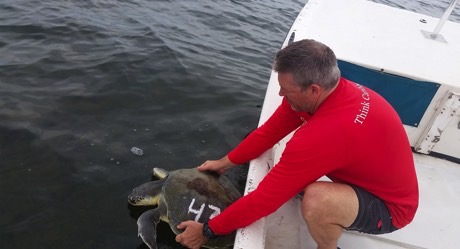
Partners & Community Involvement
The success of this project will be improved greatly by the direct involvement and support of local commercial and recreational fishing communities in the north Gulf of Mexico. STC will be conducting community outreach at the outset of the project to increase awareness about the presence of sea turtles in coastal waters and the various threats posed by human activities in the region. Most importantly, STC will work with communities to reduce threats in ways that are respectful to local cultures and avoid harmful impacts to the local community. We need locals to support turtle conservation and feel they are contributing in ways that don’t harm livelihoods, which is certainly achievable.
In addition to involving local communities, this project is itself critical to the health and sustainability of indigenous Caribbean communities that rely on sea turtle eco-tourism for their survival. The north Gulf of Mexico is literally the cradle of the young turtles that grow up and return to nesting beaches around the Caribbean and Latin America – where local communities are waiting on their return for their own sustainable livelihoods.
Partners include the Nature Coast Biological Station and the University of Florida.
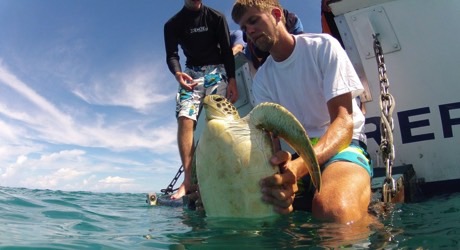
Part of a Larger Strategy
This project fits perfectly with a decades-long sea turtle monitoring and protection program initiated by Sea Turtle Conservancy in the 1950s. Over the years, this work has spread to many of the critical nesting beaches for sea turtles in the Caribbean and Latin America, where great success has been achieved on behalf of these animals. Nevertheless, many threats still confront sea turtles, which can only be addressed by doing the hard work of monitoring and protecting sea turtles in the water – and in areas that are used by turtles during different phases of their lives.
The proposed project is a logical evolution of the work STC has carried out for six decades, and it is needed to ensure all the work invested over the years is not lost. The sea turtles themselves and coastal communities throughout the Caribbean and Latin America are counting on STC to protect the turtles while they growing up in the north Gulf of Mexico.
More About the STC
The Sea Turtle Conservancy is the oldest sea turtle research and conservation organization in the world. Its work spawned the global movement to protect sea turtles, and the techniques developed by STC to monitor and protect sea turtles are in use around the globe. While sea turtles are relatively easy to protect on land, the reality is that they spend 99% of their lives in the water, where conservation efforts are much more difficult to carry out. STC has the experience and the commitment to conduct this in-water work, and this project will fill an important role in the larger, ongoing effort to protect and recover sea turtles in the Western Hemisphere.